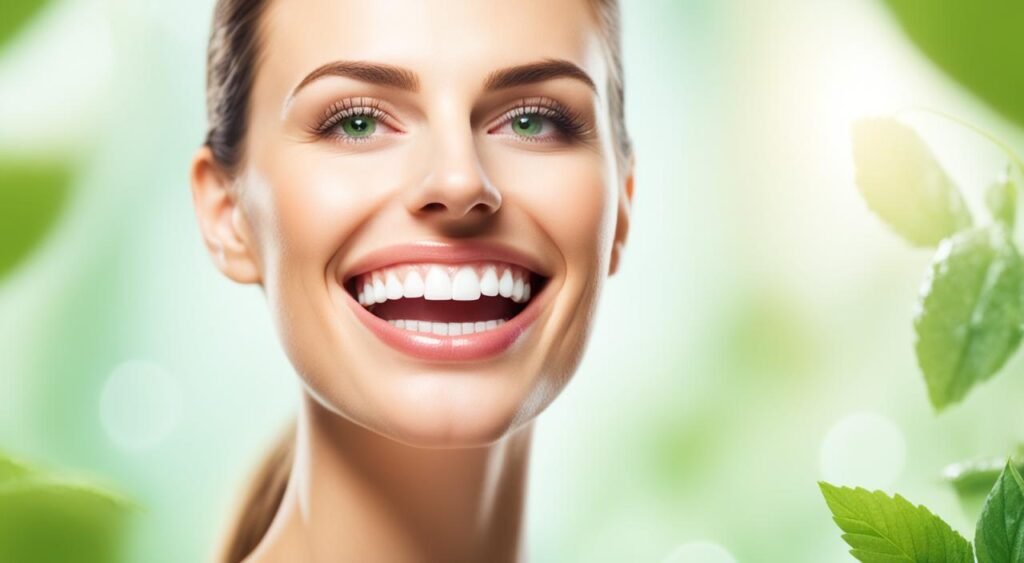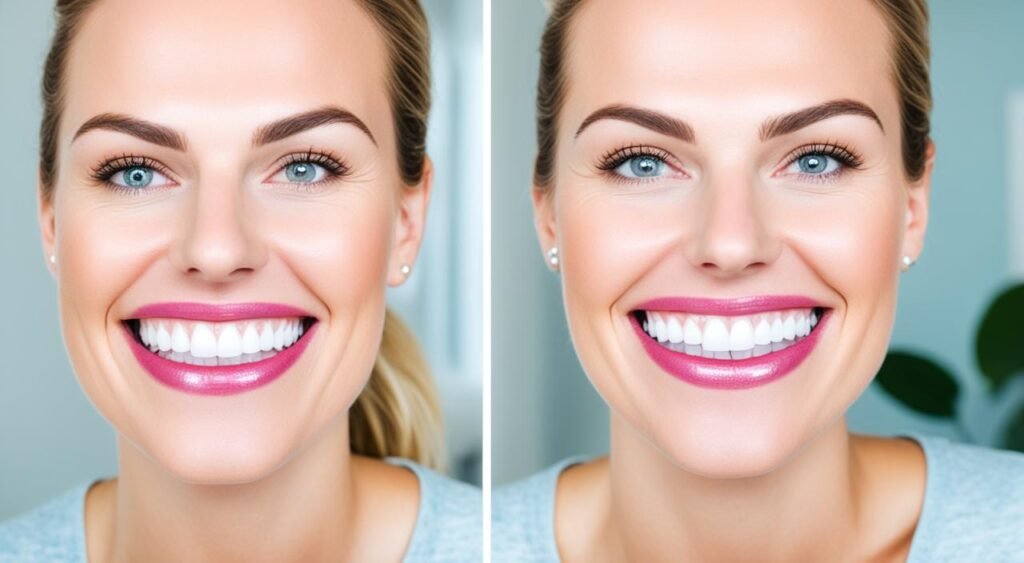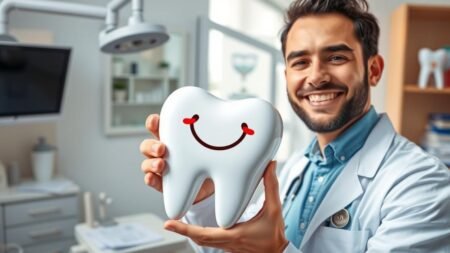Is a bright smile hiding in your pantry? Searching for teeth-whitening methods at home means checking DIY trends with care. On social media, you’ll see lots of home remedies, including DIY teeth whitening strips and DIY teeth whitening gel. But, it’s hard to know what’s safe and effective. The FDA and ADA recommend certain ways to care for your teeth.
It’s important to weigh the good and bad of making your own dental products. Can you get a whiter smile without pro help? Let’s find out. We’ll explore if DIY methods really work.
Key Takeaways
- The FDA and ADA set safe guidelines for tooth whitening substances to protect your oral health.
- Assessing DIY tips like turmeric or coconut oil pastes requires understanding their scientific backing—or lack thereof.
- Dentist-recommended concentrations and custom mouth guards ensure safer at-home bleaching experiences.
- Regular dental check-ups play an essential role in overall teeth whitening efficacy and oral care safety.
- It is crucial to consider the long-term effects on enamel when using acidic substances like lemon juice.
- Investments in at-home whitening are significant, but proper knowledge and precautions are paramount for desired outcomes.
- Understanding the benefits of ingredients like baking soda and hydrogen peroxide helps in making informed DIY decisions.
Understanding the Basics of DIY Teeth Whitening
DIY teeth whitening starts with some simple, key ingredients. These are hydrogen peroxide and baking soda. They’re not just easy to get, but they’re also great at removing stains.
The Role of Key Ingredients: Baking Soda and Hydrogen Peroxyde
Baking soda helps clean by gently scrubbing teeth. It’s known for removing surface stains. Hydrogen peroxide is a strong whitener, reaching deep into teeth to remove stains. Using both safely brightens your smile without hurting your teeth.

Potential Risks with Unfitted Mouth Guards
Using the wrong mouth guards is a big risk in DIY teeth whitening. These one-size-fits-all guards can let whitening gel touch your gums, causing irritation or harm. It’s smarter to choose mouth guards that fit your teeth well. That way, the gel stays on your teeth, away from your gums.
Importance of Accurate Ingredient Ratios for Safety
Making sure you have the right amount of hydrogen peroxide is key for safety. While it’s great that DIY teeth whitening is both flexible and affordable, it’s easy to get the mix wrong. A mix that’s too strong can harm your teeth, while a weak mix won’t work. Following expert advice can help you keep your mouth healthy while getting the results you want.
When you’re looking for a cheap and good way to whiten your teeth, always put your dental health first. Sometimes, getting advice from a dentist is the right move. They can help you use the best whitening methods for your teeth. This way, you’ll not only see good results but keep your teeth and gums healthy for a long time.
Natural Alternatives to Chemical Gels
Many people are looking for natural ways to brighten their smile. They often choose methods like oil pulling, coconut oil, and baking soda. These are loved for being simple and gentle. They work well without using harsh chemicals like peroxide. Though they may not work as fast as gels, they’re safe and have no side effects.
Oil pulling with coconut oil is a technique from Ayurvedic medicine. It involves swishing oil in your mouth to remove bacteria. This not only reduces plaque but can also whiten teeth. Baking soda, known for its mild abrasiveness, can remove stains too. It’s a key ingredient in many natural toothpastes. By staying away from harsh chemicals, these methods offer a full-care approach to oral health.
Using these natural methods means being patient. You need to keep using them regularly to see results. Below, you’ll find a simple guide to natural whitening agents and how to use them:
| Substance | Usage Method | Expected Benefit |
|---|---|---|
| Coconut Oil | Oil Pulling | Reduces bacteria, freshens breath, whitens teeth |
| Baking Soda | Brushing | Removes surface stains, whitens teeth |
| Natural Toothpaste | Brushing | Cleans and gradually whitens without harsh chemicals |
These natural methods are great but remember they’re not a replacement for seeing a dentist. Especially if your teeth are deeply stained or you have other dental issues. Use them as part of a larger plan to keep your mouth healthy and looking good.

Commercial vs. DIY Teeth Whitening Solutions
Deciding how to make your smile brighter is tough with so many options. DIY or buying from a store each have their benefits. They differ in cost, how well they work, and how fast they whiten your teeth. We will explain the key points to help you pick what’s best for you.
Over-the-counter Whitening kits are key in at-home whitting products. They are easy to use and cost less. These kits have mild peroxide to make them safer without a dentist’s help. Plus, many include tools like LED lights to boost their whitening power.
Still, if you want the fastest, most dramatic results, check out professional oral care. Their treatments are done in a dentist’s office. Prices range from $300 to $600, but you see an instantly brighter smile. This is because they use stronger peroxide gels which work faster.
- Effectiveness: One visit to a pro can make a big difference. But using DIY items might take weeks to see a change.
- Cost: Store-bought kits are much cheaper than professional treatments. They cost between $20 and $100. It depends on the brand.
- Convenience: You can use at-home kits whenever you like. No need to schedule dental visits.
- Safety: Having professionals do it lessens risks. They’re skilled to avoid irritation or harm to your teeth and gums.
Yet, some people find that store products make their teeth hurt more or feel sensitive. This can be because the products include strong bleaching agents. Using them wrong can also hurt your gums.
When choosing between DIY or store-bought teeth whiteners, think about what fits your wallet and schedule best. In 2016, people spent $1.4 billion on DIY whitening. This shows many are happy with the results they get at home. It’s something to think about for your dental care routine.
Maintaining Whitened Teeth: Tips and Practices
To keep your teeth white, some changes are needed. This is true, whether you did it yourself or with help. You must take care of your teeth well and watch what you eat to keep your smile looking good.

Auraglow 44% Teeth Whitening Gel Syringe Refill Pack, 44% Carbamide Peroxide, (3X) 5ml Syringes, 30 Whitening Treatments
Avoiding Foods and Habits That Stain Teeth
Watch what you eat and drink to avoid stains. Items like coffee, tea, red wine, and sodas can change your teeth’s color. Try to eat less of these or clean your teeth right after. Plus, smoking makes your teeth yellow. Stopping smoking can make a big difference in keeping your teeth white and your mouth healthy.
The Significance of Regular Dental Check-Ups
Visiting the dentist often is very important. They not only clean your teeth but also look for early problems. They prevent big issues like gum disease or worn enamel. Keeping your enamel strong helps prevent stains.
Want more tips for healthy and white teeth? Here are some:
- Brush at least twice a day and floss daily to remove plaque buildup and food particles.
- Include calcium-rich foods in your diet to help strengthen the enamel.
- Use mouthwash to not only freshen breath but also to rid your mouth of bacteria and potential stains.
Following these tips helps your teeth stay clean and white. It’s all about being consistent. Taking good care of your teeth every day will keep them looking their best. A bright, white smile starts with good choices!
Conclusion
Deciding to whiten your teeth at home can be a big step. DIY methods seem cheap and put you in control. Yet, there are hidden risks like harming your teeth and dental work.
It’s crucial to be careful with at-home whitening. Make sure your oral health is your top priority. There are possible dangers and costs you might not see right away.
If you choose home kits, know the outcome could vary a lot. They might make your teeth look better, but the change could be uneven. And, they could make your teeth hurt if you don’t use them right.
Professional whitening gives quicker, more dependable results. But it usually costs more. Whatever path you take, understand the options and talk to a dentist first.
Remember, a bright smile doesn’t just come from whitening. It’s key to keep up your general dental care. Regular check-ups and a good oral routine are vital.
Choosing a brighter smile is serious. Do your homework and focus on your health. Make smart decisions that look after your well-being.
FAQ
Is DIY teeth whitening at home a safe and effective way to achieve a brighter smile?
DIY teeth whitening can save money. But, it’s key to be safe and effective. Use hydrogen peroxide in FDA-approved amounts. Always get a mouthguard from the dentist for protection. This guards against gum irritation and ensures an even spread.
What are the key ingredients for making a homemade teeth whitening gel?
Baking soda and hydrogen peroxide are DIY whitening gel mainstays. They clean and bleach teeth. Yet, using them wrongly can harm the teeth and gums. So, handle with care.
Can using unfitted mouth guards pose any risks during DIY teeth whitening?
Using the wrong mouth guard might not apply gel evenly. It can also spill onto the gums, causing issues. Always use a mouth guard that fits well. Your dentist can make one just for you to keep things safe.
Why is it important to have accurate ingredient ratios in DIY teeth whitening?
Right ratios are vital for DIY whitening’s success and safety. Too much hydrogen peroxide harms. Too little might not whiten enough. Follow ADA guidelines closely for the safest and best outcomes.
Are there natural toothpaste alternatives that can help whiten teeth?
Options include oil pulling with coconut oil or tooth brushing using baking soda. These can help keep your mouth healthy. However, they might not whiten as fast as chemical gels and are more subtle.
How do over-the-counter whitening kits compare to DIY teeth whitening solutions?
Store-bought whitening kits are easy to use and quick to show results. They have measured peroxide for safety. If you like natural ways, DIY may be better for you.
What daily habits should I change to maintain my teeth after whitening?
To keep your teeth white, avoid coffee, red wine, and tobacco. Brush after eating or drinking stain-causing food. Also, eat foods high in calcium to make your teeth stronger and maintain hygiene.
How often should I visit the dentist to maintain a brighter smile after teeth whitening?
Visit your dentist every six months for a check-up. These visits keep your smile bright. Professional cleanings remove surface stains and protect your teeth and gums for a whiter smile.









2 Comments
Pingback: Will Teeth Whitening Damage Enamel? Find Out the Facts
Pingback: Get Bright White Teeth: Tips for a Dazzling Smile